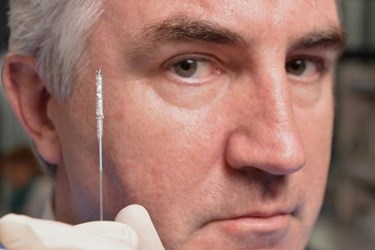Cell-Based Stent May Provide Alternative To Open Heart Bypass Surgery
By Chuck Seegert, Ph.D.

Coronary bypass and peripheral bypass surgery typically involves a major open heart operation. Finding a less invasive approach has been the goal of a research team at the University College Cork (UCC) in Ireland, in collaboration with the Mayo Clinic in Rochester, Minn. The results of their work may reduce the numbers of bypass surgeries and even make it possible for higher-risk patients to be treated.
Every year about 3 million open heart arterial bypass procedures are performed, surgeries that are extremely invasive and carry many risks. The surgery is so invasive that about 20% of patients who need it are prevented from having it due to other health conditions, according to a recent press release from UCC. This untreatable population, along with the risks to those who are operated on, led the team of investigators to develop ways of helping people regrow blood vessels without major surgery.
The lead investigator, professor Noel Caplice, began his studies in this area while working at the Mayo Clinic and then continued after returning to UCC, according to the press release. The device is a derivative of the stents that are commonly used to reopen arteries that have partially closed. This stent has been modified, however, to allow it to carry millions of cells that provide signaling molecules to the vessel being treated. The molecule, in this case vascular endothelial growth factor (VEGF), facilitates improved healing and eventually restores blood flow to the artery.
Cells used in the device are autologous smooth muscle cells, taken from the patient themselves and then modified using gene therapy, according to a research study published the journal Biomaterials. In culture outside the body, the cells are treated using gene therapy and induced to produce greater amounts of VEGF. Implanting these cells into swine — an animal model that is often used the cardiovascular space because of its similarities to humans — Caplice was able to show that partially occluded arteries had an increased blood flow that was much closer to normal.
“If reproduced in humans this device would offer an alternative to open surgical bypass operations with implications for treatment of patients who are currently inoperable. It also has the potential to reduce costs and time spent in hospital.” said Caplice, a practicing interventional cardiologist and director of the Centre for Research in Vascular Biology at UCC, and chair of Cardiovascular Sciences.
The next step is to test the device in patients who require bypass surgery but are considered unfit for surgery. The team hopes to complete its work over the next three to five years, Caplice said in the press release.
Using cells to repair cardiovascular structures is the focus of many research groups due to the promise of results like those seen here. Other researchers have focused on defining cell combinations that may allow portions of the cardiac tissue to be regenerated.
Image credit: University College Cork
